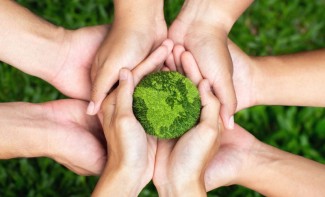
The people of Hawaii have always cared for and revered the Hawaiian Islands and the 'Aina (earth, land). Ancient Hawaiians lived a very sustainable lifestyle. They used tropical material for housing and lava rocks for building temples (heiau). They also had highly sophisticated agricultural farming methods that worked in harmony with nature. To continue their aloha ‘aina (love of the land), we should do what we can as responsible individuals to reduce our environmental impact in this world. One of the most effective ways of doing that is by eating sustainably. Here’s how:
Reduce or eliminate consumption of meat products (especially beef)
Even if it’s just one meal a week, it can still make a difference. Meat consumption has the highest impact of environmental damage because of land and water use, as well as methane gas produced by cows. In 2006 the United Nations reported that raising animals for food generates more green house gases than all the cars and trucks combined.1 Thus, the single most important thing you can do for the environment is to adopt a plant-based diet.
Eat local whenever available
In addition to getting fresher, riper, more nutritious food, seventeen percent less carbon dioxide is emitted into the atmosphere when you buy local/regional.2 Plus local food also promotes biodiversity and supports our local farmers.
Eat seasonally
Buying “seasonal” foods avoids carbon emissions produced by heavily oil-operated boilers which heat greenhouses and power plants.
Eat organic or close to it
Eat organically grown foods in order to cut down on chemicals, pesticides, and GMOs (genetically modified organisms). Some foods may not be “certified organic” but may be “pesticide-free”, “GMO free”, etc. You can reduce your exposure (and the Earth’s exposure) to chemicals by 80% by avoiding the most contaminated foods in the grocery store. Check out a list of most and least heavily treated foods.
Buy “bulk” food
Buy in bulk quantities to reduce packaging and save money. Bulk foods are sold by the pound, herbs and spices by the ounce, so you can get just the amount you need. Buying bulk is very economical as it eliminates waste and the cost of unnecessary packaging. You can also decrease the waste from plastic, cardboard, boxes, and bags by recycling and reusing. A sustainable, low-carbon diet is based on mostly grain and vegetables (no beef and other meats), local, unprocessed, organic (or least contaminated), seasonal, and has little to no packaging. Of course, this is not always possible to achieve, but it is a good standard to know and try to follow whenever you can. You may only be able to do one or two of these things at different times, which is still great. By knowing this standard the next time you shop, you may find yourself automatically incorporating some of these sustainable habits….little by little, every bit helps. Aloha 'aina, malama ‘aina; love and respect the land, make it yours and claim stewardship for it. Care for and nurture the land so it can give back all we need to sustain life for ourselves and our future generations.
- “Livestock a major threat to environment,” United Nations FAO Newsroom, Nov. 29, 2006.
- Leopold Center for Sustainable Agriculture. Iowa State University. Report: Food, Fuel, and Freeways: An Iowa perspective on how far food travels, fuel usage, and greenhouse gas emissions. June 2001.